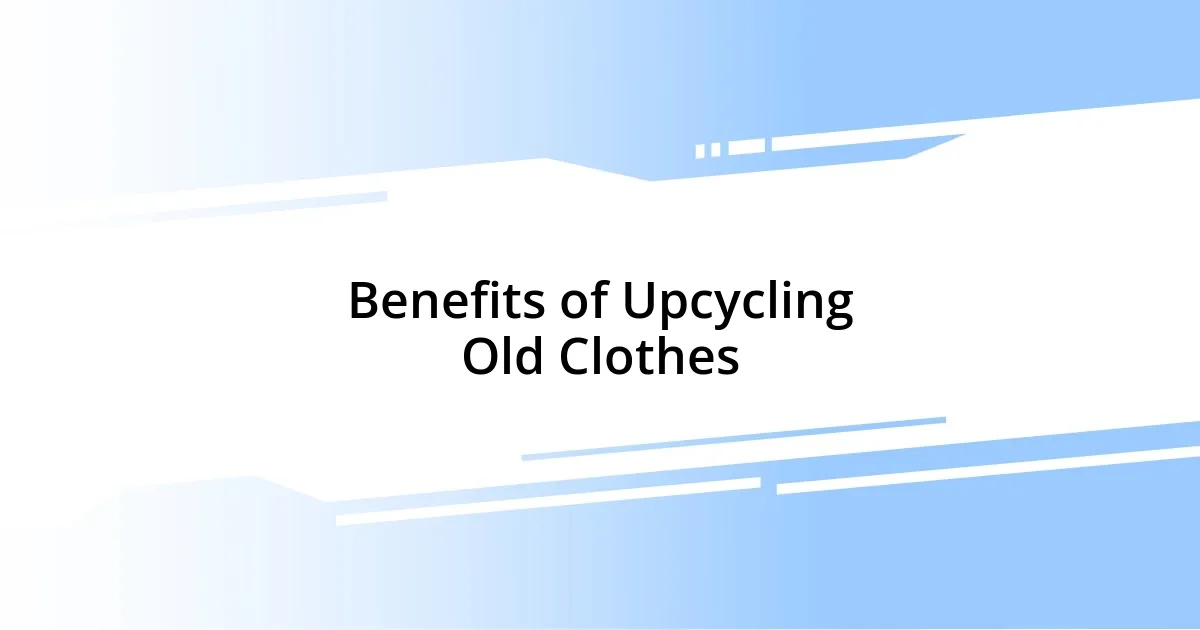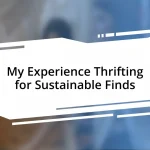Key takeaways:
- Upcycling fashion promotes sustainability by transforming old garments into new, functional items, fostering creativity and a deeper appreciation for craftsmanship.
- The process is cost-effective and builds emotional connections to clothing, turning the act of creating into a personal narrative and a form of self-expression.
- Engaging in upcycling activities cultivates a sense of community, inspiring others to rethink their fashion choices and join the movement against fast fashion.
- Sharing upcycled creations fosters connections and encourages others to explore their creativity through workshops and community events.

Introduction to Upcycling Fashion
Upcycling fashion isn’t just a trend; it’s a movement that breathes new life into old garments. I remember the first time I transformed a pair of worn-out jeans into a stylish tote bag. The thrill of turning something seemingly useless into a functional piece sparked a passion in me that I never knew existed. Isn’t it fascinating how a little creativity can change our perspective on what clothing means?
At its core, upcycling is about sustainability, albeit with a generous splash of creativity. Each piece tells a story, a connection to the past that we can elevate into something new. Imagine sifting through your closet and discovering a forgotten shirt; how might it be reimagined? I find that this process not only rejuvenates clothing but also fosters a deeper appreciation for the craftsmanship behind fashion.
Moreover, embracing upcycling can empower us in our consumer habits. When I upcycle, I feel like I’m making a choice that counters fast fashion’s throwaway culture. It’s not just about style; it’s about valuing resources and taking deliberate steps toward a more conscious lifestyle. How rewarding is it to wear something unique that carries a personal touch?

Benefits of Upcycling Old Clothes
Upcycling old clothes offers a fantastic opportunity to tap into your creativity while making a positive impact on the planet. I remember transforming an old sweater into a cozy cushion cover. It felt rewarding not only to give that fabric a new purpose but also to know I was keeping it out of a landfill. Every time I see that cushion on my couch, it brings back memories—not just of the sweater, but of the satisfaction I felt during the crafting process.
Furthermore, upcycling can be quite cost-effective. Think about it: instead of spending money on new pieces that might not even have the character you desire, you can revitalize your wardrobe by simply reworking what you already own. When I upcycled my old t-shirt into a crop top, I saved money, and it became one of my favorite pieces because it was made with such personal flair and intention.
Lastly, the emotional benefits of upcycling shouldn’t be underestimated. There’s a connection you build with your creations—each stitch feels like a small victory over consumerism. When I wear something I’ve personalized, I often get compliments, and it sparks conversations. It’s surprising how many stories can unfold from a single outfit, don’t you think? This personal narrative associated with clothing enhances not just my wardrobe but also my self-expression.
| Benefit | Description |
|---|---|
| Environmental Impact | Reduces waste and minimizes the need for new resources. |
| Cost-Effectiveness | Transforms existing garments into new styles, saving money. |
| Emotional Connection | Fosters creativity and personal expression through crafted pieces. |

Tools and Materials for Upcycling
When I dive into upcycling, having the right tools and materials is essential. It’s amazing how a simple toolkit can transform my vision into reality. I still remember the thrill of pulling out a pair of scissors, a needle, and thread from my sewing kit for the first time. Those basic tools unlocked endless possibilities. The joy comes, of course, from giving a second life to what could have been discarded.
Here’s a list of tools and materials that have become my trusty companions:
– Sewing Machine: A real game changer for efficiency and precision.
– Scissors: Sharp fabric scissors help achieve clean cuts.
– Needles and Thread: Essential for sewing pieces together; I often choose thread colors that complement or contrast my fabric for a unique touch.
– Fabric Glue: Great for quick fixes or no-sew projects.
– Pins & Clips: These keep my fabric in place as I work on intricate designs.
– Measuring Tape: Accuracy is key, especially when altering sizes.
– Old Clothing: The main ingredient! I love exploring my closet to find pieces that can be revived.
Embracing these tools feels like embarking on an artistic journey every time. There’s a certain magic that happens as I watch a transformed piece emerge from a pile of fabric. When I crafted a fringed kimono from an oversized sweater, I felt like I was channeling my inner designer, accessorizing it with beads and charms to give it a personal flair. It’s truly liberating to watch my imagination come to life in new garments.

Creative Techniques for Upcycling Clothes
There are countless creative techniques to breathe new life into old clothes, each offering a unique way to showcase personal style. One of my favorite methods is fabric dyeing. I once experimented with tie-dye on a white dress that felt too plain. The process was exciting, and the result was a vibrant, custom piece that sparked joy every time I wore it. Isn’t it fascinating how something so simple can completely change how we perceive a garment?
Another technique I enjoy is patchwork. I have an old pair of jeans that were starting to show signs of wear. Instead of retiring them, I cut out fun shapes from old T-shirts and sewed them on, creating an eye-catching design. This approach not only added character but also made those jeans feel like a new, intentional statement piece. It’s amazing how personal touches can make a difference, right?
Don’t overlook embellishments! Adding beads, embroidery, or even lace can transform something ordinary into a fashion-forward item. When I jazzed up an old black tank top with hand-stitched embroidery, it turned into a stylish piece I received so many compliments on. Turning the mundane into the stylish reaffirms our creativity and shows that the only limit is our imagination. What will you create next?

Step-by-Step Upcycling Projects
One step I really enjoy is transforming an old shirt into a trendy tote bag. It’s a simple project! I remember my first attempt: I cut off the sleeves and the neck, then stitched the bottom closed. The moment I finished and held it up, I felt like I’d unlocked a new skill. That tote became my go-to for grocery shopping, and I often received compliments on it. Who would have thought an old shirt could turn into such a practical and stylish accessory?
Another fun project involves repurposing jeans into stylish shorts. It starts with finding that worn-out pair that has seen better days. I usually try them on and mark the desired length before cutting. My first pair turned out too short at first, but after adding some frayed edges, they evolved into a chic summer staple! Every time I wore them, it felt like I had a unique piece that stood out from the crowd. Isn’t it exhilarating to wear something you’ve created?
Lastly, I’ve had a blast experimenting with upcycled fabric scraps for patchwork skirts. After watching a few videos, I gathered remnants of my favorite old clothes and combined them layer by layer. The process felt like storytelling through fabric. Each patch had a memory attached; it wasn’t just a skirt but a collection of moments stitched together. I can’t help but ask: how does it feel to wear your memories? It’s a beautiful reminder that our creativity has the power to tell our stories.

Sustainable Fashion and Its Impact
Sustainable fashion is more than just a trendy phrase; it’s a necessary shift in how we approach clothing consumption. I remember standing in front of my overflowing closet, realizing how many pieces I had barely worn. Each one represented not just a purchase but also the environmental cost of production. Reflecting on this, I decided to change my buying habits. The thrill of creating something new from what I already had ignited a passion within me.
When we talk about the impact of sustainable fashion, it really goes beyond individual choices. Each upcycle project I’ve embarked on feels like a small act of rebellion against fast fashion. For instance, transforming an outdated blazer into a chic crop top not only gave new life to an unwanted piece but also inspired friends to rethink their wardrobes. Isn’t it empowering to know that our choices can influence others? The joy of sharing these transformations amplifies the message of sustainability.
I often feel that sustainable fashion cultivates a sense of community. Joining local workshops, I’ve connected with others who share a love for reviving forgotten pieces. One memorable event involved exchanging fabrics with fellow upcyclers, reminding me how interconnected we all are in this journey. Each shared tip and creative insight helped reinforce that we’re all part of a larger movement toward sustainable living. How great is it to be part of something that resonates deeply with so many people?

Sharing Your Upcycled Creations
Sharing your upcycled creations is one of the most fulfilling parts of the crafting journey. When I posted a picture of my first patchwork skirt on social media, the positive feedback flooded in. Friends reached out, not just to compliment, but to ask how I made it. It felt amazing to inspire others to get started on their own upcycling adventures. Isn’t it wonderful to connect with people who might be on similar journeys, exploring their creativity?
I also enjoy participating in community events where I can showcase my upcycled fashion. I remember bringing a few pieces to a local fair and watching people stop and admire what I had done with discarded clothes. It was heartwarming to see their faces light up with ideas of their own. Engaging with others over upcycling felt like building a bridge between creativity and sustainability. Have you ever felt that rush of excitement when someone shows genuine interest in your work?
Another way I share my upcycled creations is through workshops. Teaching others how to transform their clothing has not only solidified my own skills but also created a space for shared learning. I recall one participant who looked skeptical about her ability to create but left with a beautiful bag made from an old dress. Her proud smile was infectious. How rewarding is it to witness someone discover their hidden talents, all sparked by sharing a simple upcycled project? Each creation has the power to uplift and inspire, making the world of sustainable fashion feel even more connected.













